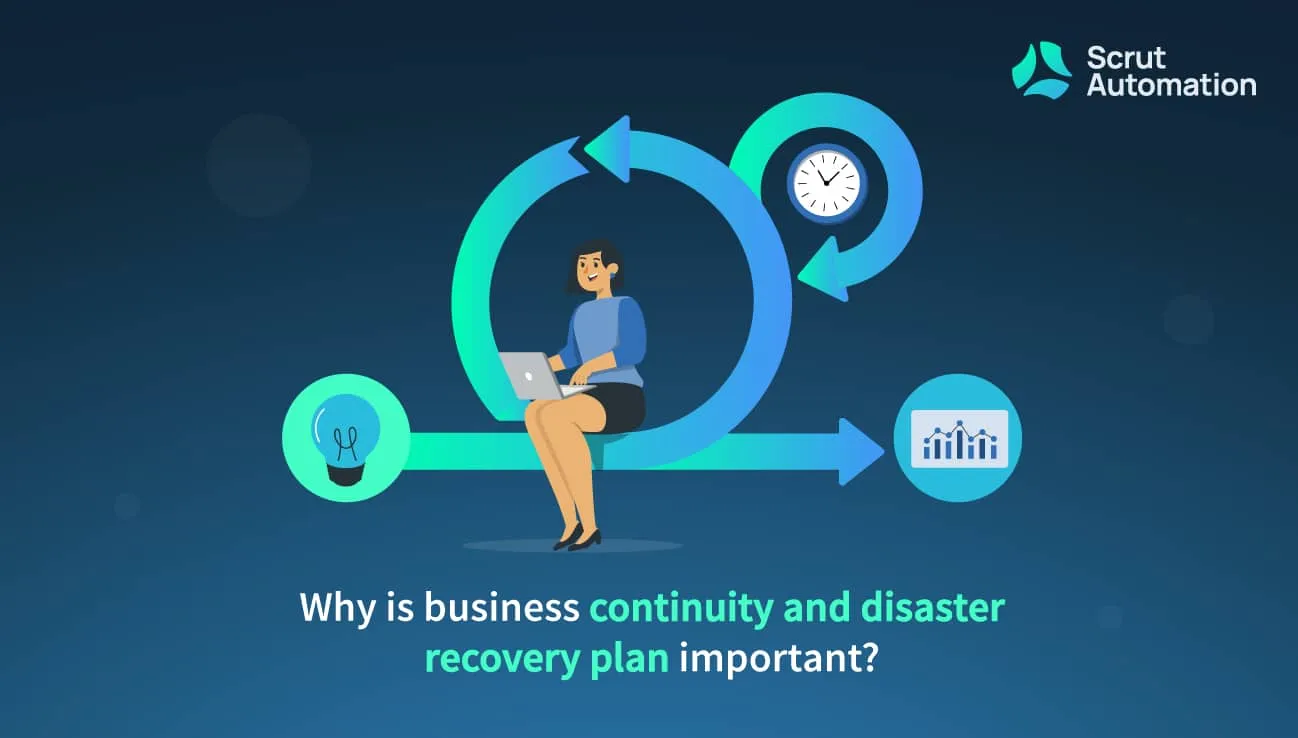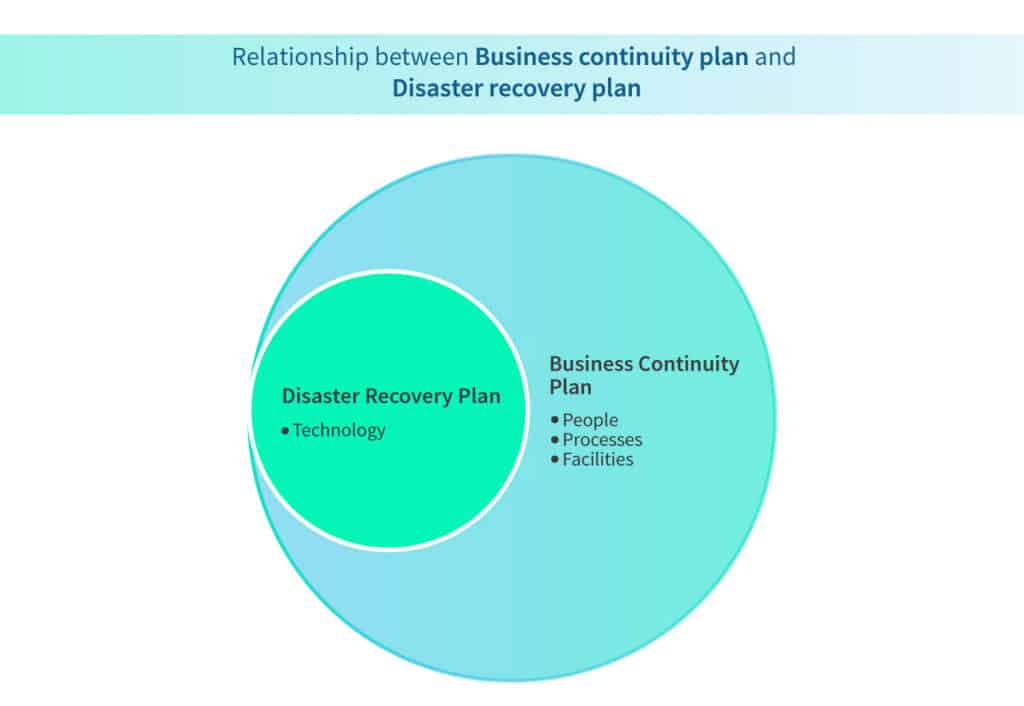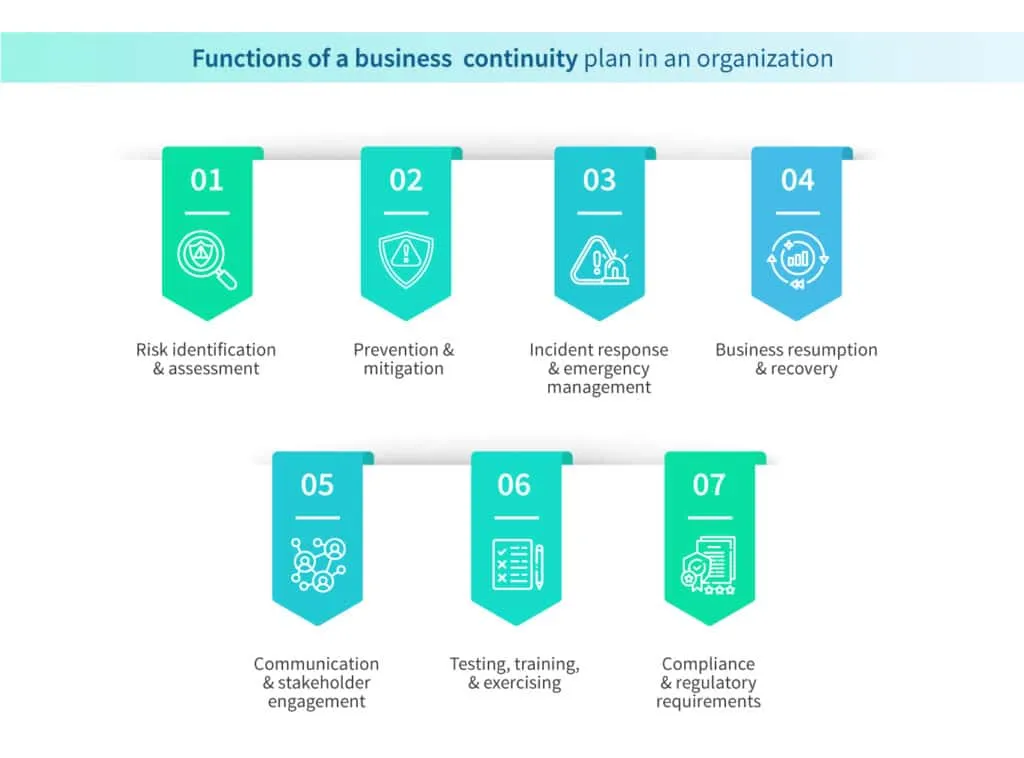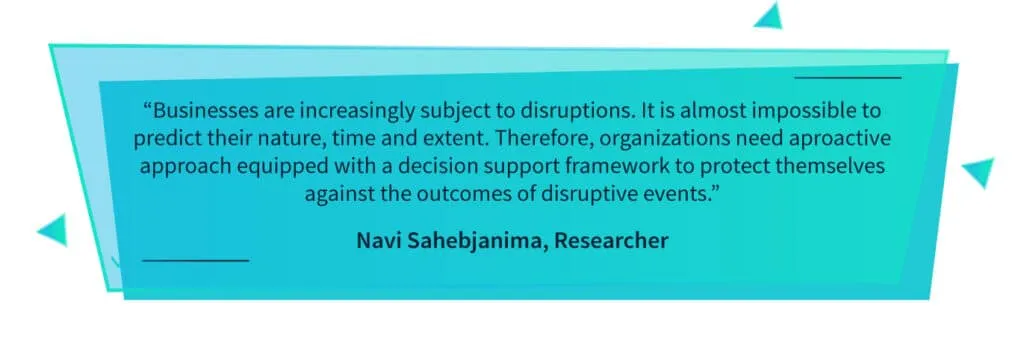Mitigating disruption: The importance of business continuity and disaster recovery plans

In today’s rapidly evolving business landscape, organizations face numerous challenges that can disrupt their operations and threaten their survival. From natural disasters and cyber attacks to system failures and supply chain disruptions, businesses must be prepared to navigate these uncertainties.
An organization can mitigate risks by maintaining a risk register and following an IT risk management process. However, it cannot dissolve all the uncertainties in business operations.
This is where the importance of business continuity and disaster recovery plans comes into play.
Understanding business disruptions

Business disruptions can occur in various forms and have the potential to significantly impact organizations. By expanding on different types of disruptions, we can deepen our understanding of their implications and highlight the importance of preparedness.
1. Natural disasters
- Severe weather events like hurricanes, tornadoes, floods, wildfires, and other weather-related disasters
- Geological events such as earthquakes, volcanic eruptions, and landslides
2. Cyber attacks
- Data loss and financial losses due to cyber attacks such as malware and ransomware
- Social engineering attacks such as phishing, vishing, and spear phishing
- Distributed Denial of Service (DDoS) on websites and applications
3. System failures and IT disruptions
- Hardware and software failures like software glitches, compatibility issues, downtime, data loss, and customer dissatisfaction due to hardware failure
4. Data center outages
- Data center failures, including the loss of critical systems, prolonged downtime, and compromised data integrity
5. Supply chain disruptions
- Consequences of supplier bankruptcy or sudden closure of business operations
6. Regulatory and compliance changes
- New legislation or regulations: Changes in laws and regulations can create challenges for organizations to adapt and comply. The potential consequences of non-compliance include fines, legal action, and reputational damage
7. Manually caused factors
- Disruptions like labor strikes, employee shortages, or key personnel departures on business continuity and operations
- Human mistakes, negligence, or intentional actions can result in system failures, data breaches, or operational disruptions
By expanding on these business disruptions, organizations can better understand the potential risks they face and the need for robust business continuity and disaster recovery plans. Taking proactive measures to mitigate these risks ensures organizational resilience and the ability to navigate disruptions with minimal impact.
What is a business continuity plan?
Business continuity planning is the process of developing and implementing procedures to ensure that a business can continue to operate in the event of a disaster. This could include a natural disaster, a cyber-attack, or a power outage.
What is a disaster recovery plan?
Disaster recovery planning refers to the process of creating and implementing strategies, procedures, and measures to recover and restore critical systems, data, and infrastructure in the event of a disaster or significant disruption. It involves analyzing potential risks, defining recovery objectives, and developing detailed plans and procedures to enable the timely recovery of IT systems and minimize the impact on business operations. The goal of disaster recovery planning is to ensure that the organization can resume critical functions within a reasonable timeframe and minimize data loss.

Disaster recovery planning (DRP) is a subset of business continuity planning (BCP) that specifically focuses on the recovery and restoration of critical systems, data, and infrastructure following a disruptive event. While BCP encompasses a broader scope of activities to ensure the overall continuity of business operations, DRP specifically addresses the technical aspects of recovering IT systems and assets.
What is the role of business continuity and data recovery plans?

The role of a business continuity plan and data recovery (BCPDR) plan is to ensure the resilience and continuity of an organization’s critical operations during and after a disruptive event. The BCPDR plays a crucial role in minimizing the impact of disruptions, maintaining essential services, and enabling a swift recovery. Here are some key roles of a business continuity and disaster recovery plan:
1. Risk identification and assessment
The BCPDR helps identify potential risks and vulnerabilities that could disrupt business operations. It involves conducting a comprehensive risk assessment to understand the likelihood and potential impact of various threats. This step allows organizations to prioritize their planning efforts and allocate resources effectively.
2. Prevention and mitigation
Business continuity planning involves implementing preventive measures to reduce the likelihood of disruptions and mitigate their potential impact. This can include measures such as redundancy planning, implementing robust security protocols, regular maintenance of critical systems, and implementing backup solutions.
A data recovery plan helps mitigate the impact of data loss by implementing preventive measures such as regular backups, and data redundancy and integrity checks. These measures help ensure that sensitive information is protected and available for recovery in case of accidental deletion, hardware failure, cyber-attacks, or other data loss events.
3. Incident response and emergency management
A crucial role of the BCPDR is to outline the procedures and protocols for effectively responding to incidents and managing emergencies. It defines roles and responsibilities, establishes communication channels, and provides guidance on activating emergency response teams. This ensures a coordinated and structured response, minimizing confusion and enabling timely decision-making.
4. Business resumption and recovery
The BCP outlines strategies and procedures for resuming critical business functions and recovering from disruptions. This includes defining recovery time objectives (RTO) and recovery point objectives (RPO) to guide the restoration of systems, processes, and data. It also includes strategies for relocating operations, sourcing alternative suppliers, and restoring customer services.
5. Communication and stakeholder engagement
During a disruption, effective communication is crucial. The business continuity plan includes communication plans to ensure timely and accurate information sharing with employees, customers, suppliers, and other stakeholders. It provides guidelines for internal and external communication channels, key messages, and designated spokespersons, ensuring transparency and building trust.
6. Testing, training, and exercising
Regular testing, training, and exercising of the BCP are vital to evaluate its effectiveness and ensure preparedness. This includes conducting mock drills, tabletop exercises, and simulations to validate the plan’s functionality, identify gaps, and train personnel on their roles and responsibilities. Feedback and lessons learned from these activities inform plan enhancements and continuous improvement.
7. Compliance and regulatory requirements
The BCP helps organizations meet compliance and regulatory obligations. It ensures that the organization’s operations align with industry standards, legal requirements, and contractual obligations. By demonstrating a robust BCP, organizations can instill confidence in stakeholders, regulators, and customers regarding their ability to handle disruptions effectively.
By fulfilling these roles, a business continuity and data recovery plan provides organizations with a roadmap to navigate disruptions, minimize downtime, protect critical assets, maintain customer trust, and ensure the continuity of essential operations. It is a proactive approach that enables organizations to respond effectively to disruptions, safeguard their reputation, and swiftly recover from adverse events.

Benefits of business continuity and disaster recovery plans

Business continuity and disaster recovery plans offer numerous benefits to organizations. These plans help mitigate the impact of disruptions, minimize downtime, and ensure the continuity of essential operations. Here are some key benefits of implementing business continuity and disaster recovery plans:
1. Minimize downtime and financial loss
By having a well-defined plan in place, organizations can minimize downtime and the associated financial losses caused by disruptions. The ability to quickly recover and resume operations reduces the impact on revenue, customer service, and productivity, safeguarding the organization’s financial stability.
2. Maintain customer trust and reputation
Effective business continuity and disaster recovery plans demonstrate an organization’s commitment to serving its customers even in challenging circumstances. By minimizing disruptions and providing uninterrupted services, organizations maintain customer trust and preserve their reputation.
3. Regulatory compliance
Many industries have regulatory requirements mandating the implementation of business continuity and disaster recovery plans. Adhering to these regulations helps organizations avoid penalties, legal issues, and reputational damage. It also ensures that critical systems and data are adequately protected.
4. Enhanced organizational resilience
Business continuity and disaster recovery plans build resilience within an organization. They promote a proactive approach to risk management, enabling organizations to identify vulnerabilities, implement preventive measures, and effectively respond to disruptions. This resilience helps organizations withstand challenges and adapt to changing circumstances.
5. Safeguard critical data and systems
Data is a valuable asset for organizations, and business continuity and disaster recovery plans help safeguard this data. Through regular backups, redundant systems, and recovery strategies, these plans ensure the availability, integrity, and confidentiality of critical information. This protects organizations from data loss, breaches, and other cybersecurity incidents.
6. Effective risk management
Business continuity and disaster recovery plans enable organizations to identify and assess risks comprehensively. By analyzing potential threats and vulnerabilities, organizations can develop strategies to mitigate and manage those risks effectively. This proactive approach to risk management enhances overall organizational resilience.
7. Employee safety and well-being
Business continuity and disaster recovery plans prioritize employee safety and well-being. These plans outline protocols and procedures to ensure the safety of employees during disruptive events. By providing clear guidance, organizations can effectively manage employee evacuation, communication, and support during crises.
8. Stakeholder confidence
The implementation of business continuity and disaster recovery plans instills confidence in stakeholders, including customers, partners, suppliers, and investors. These plans demonstrate that an organization is prepared to handle disruptions, maintain operations, and fulfill its commitments. This confidence strengthens relationships and fosters long-term partnerships.
9. Continuous improvement
Business continuity and disaster recovery plans are not static documents. Regular testing, training, and reviews help identify areas for improvement and allow organizations to enhance their preparedness over time. The iterative nature of these plans ensures that they remain up-to-date and effective in the face of evolving risks and challenges.
By realizing these benefits, organizations can effectively navigate disruptions, protect their interests, and maintain their ability to serve customers and stakeholders. Business continuity and disaster recovery plans are vital tools for building resilience and ensuring the long-term success of an organization.
Final words
Business continuity and disaster recovery plans are essential for organizations to navigate disruptions effectively. They mitigate downtime, safeguard critical assets, maintain customer trust, ensure regulatory compliance, and enhance organizational resilience.
By proactively preparing for risks, organizations can protect their interests and maintain their ability to serve customers and stakeholders. Embracing these plans is crucial for long-term success in today’s unpredictable business landscape.
Scrut experts can help you in developing and implementing a business continuity and disaster recovery plan. You can connect with our experts by clicking here.
FAQs
What is a disaster recovery plan?
A disaster recovery plan is a set of predefined processes and protocols designed to recover and restore IT systems, data, and infrastructure after a disaster or significant disruption, ensuring business continuity.
What is the role of a disaster recovery plan?
The role of a disaster recovery plan is to enable the organization to recover and restore critical systems and data, minimizing the impact of a disruption on business operations, customer service, and productivity.
What are the benefits of business continuity and disaster recovery plans?
Business continuity and disaster recovery plans offer several benefits, including minimizing downtime and financial loss, maintaining customer trust and reputation, ensuring regulatory compliance, enhancing organizational resilience, safeguarding critical data and systems, enabling effective risk management, promoting employee safety and well-being, instilling stakeholders’ confidence, and fostering continuous improvement.


















